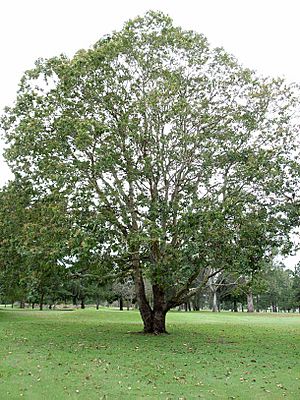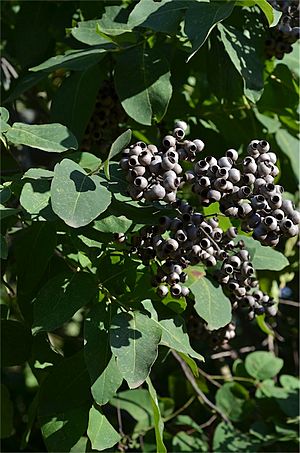Cadaghi facts for kids
Quick facts for kids Cadaghi |
|
|---|---|
 |
|
| Corymbia torelliana at Urunga, New South Wales | |
| Scientific classification | |
| Genus: |
Corymbia
|
| Species: |
torelliana
|
| Synonyms | |
|
Eucalyptus torelliana F.Muell. |
|
The Corymbia torelliana, often called cadaghi or cadaga, is a special tree. It grows only in North Queensland, Australia. This tree has smooth, greenish-grey bark. Older trees might have rough bark near the bottom. Its leaves can be egg-shaped or heart-shaped. The cadaghi tree has white flowers and fruit that looks like an urn.
Contents
What Does the Cadaghi Tree Look Like?
How Tall Does It Grow?
The cadaghi tree usually grows very tall. It can reach heights of about 25 to 30 meters (82 to 98 feet). That's as tall as a 10-story building!
Its Bark and Leaves
The bark of the cadaghi tree is mostly smooth. It is a greenish-grey or white color. On older trees, the bark near the bottom can be rough and grey.
Young cadaghi plants have shiny green leaves. These leaves are shaped like a heart or an egg. They are about 9 to 14.5 centimeters (3.5 to 5.7 inches) long. Adult leaves are a bit different. They are also egg-shaped or heart-shaped. They can be up to 16 centimeters (6.3 inches) long.
Flowers and Fruit
The flowers of the cadaghi tree are white. They grow in small groups of three or seven. You can see these flowers from August to November. After the flowers, the tree grows woody fruit. This fruit is shaped like an urn or a round pot. It is about 9 to 14 millimeters (0.35 to 0.55 inches) long.
How the Cadaghi Tree Got Its Name
Naming the Tree
Scientists gave the cadaghi tree its official name. In 1877, a scientist named Ferdinand von Mueller first described it. He called it Eucalyptus torelliana. Later, in 1995, two other scientists, Ken Hill and Lawrie Johnson, changed its name. They renamed it Corymbia torelliana.
Who Was Torelli?
The second part of the name, torelliana, honors a person named Count Luigi Torelli. He had an interesting idea. He thought that planting trees like eucalypts could help dry out wet, marshy areas. This would help reduce a disease called malaria.
Where Does the Cadaghi Tree Grow?
Its Natural Home
The cadaghi tree naturally grows in North Queensland. You can find it from Cooktown down to Ingham. It likes to grow in wet forests. It also grows on the edges of rainforests.
Growing Beyond Its Home
People have planted the cadaghi tree in other places. They use it in gardens and for landscaping. Because it grows fast, it has spread beyond its natural home. Now, you can find it in other parts of Queensland too.
Is the Cadaghi Tree a Problem?
A "Weed" in Some Areas
In some parts of Queensland, the cadaghi tree is seen as a "weed." This means it grows where it's not wanted. It can grow along roadsides and waterways. It also grows in disturbed areas.
Impact on Other Plants and Bees
The cadaghi tree has a thick canopy of leaves. This can block sunlight from reaching smaller plants below. This makes it hard for native plants to grow.
The tree also produces a sticky resin from its fruit. Native stingless bees, like the Tetragonula carbonaria, collect this resin. But sometimes, the resin can clog their honeycombs. It can even seal the entrance to their hive. This can sadly kill the bees inside.
Using the Cadaghi Tree in Gardens
A Fast-Growing Shade Tree
The cadaghi tree grows very quickly. People have used it as a street tree and in gardens. It provides a lot of shade because of its big leaves. This makes it popular in hot, inland towns.
Things to Watch Out For
However, there are some problems with using this tree. A black, sooty fungus can grow on it. This fungus can make things underneath the tree dirty. Also, large branches can sometimes break off. This can be dangerous.
Because of the problems it causes for native plants and bees, experts suggest other trees. Some good alternatives are brush box (Lophostemon confertus), Moreton Bay ash (Corymbia tessellaris), and Queensland maple (Flindersia brayleyana).
Images for kids






